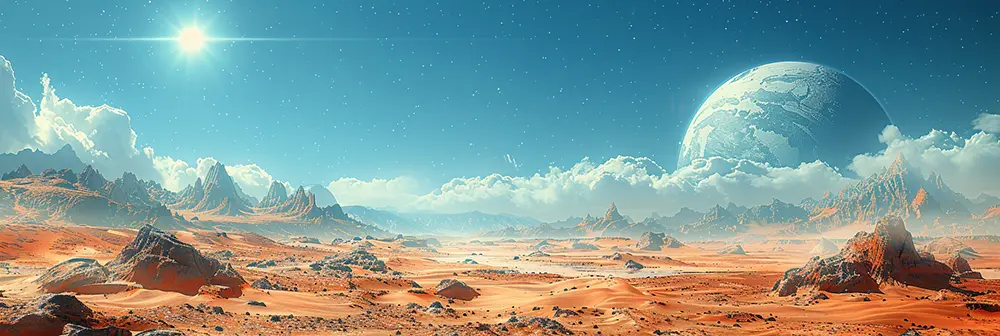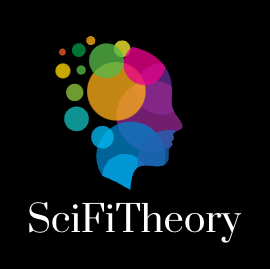Hard Science Fiction
Hard science fiction emphasizes scientific accuracy and technical detail, focusing on the realistic and precise depiction of scientific concepts and technological advancements. This subgenre often explores the implications of these developments in a plausible manner.
Scientific Accuracy: Hard science fiction is distinguished by its commitment to scientific rigor, making it a favorite among readers with a strong interest in science and technology. The stories are grounded in real-world science, adhering to the laws of physics, chemistry, and other scientific principles to create a sense of realism and authenticity. This approach involves detailed research and a thorough understanding of current scientific knowledge, which is then projected into plausible future scenarios.
Classic Examples:
– Arthur C. Clarke’s “2001: A Space Odyssey”: This novel, along with its film adaptation, is known for its meticulous attention to scientific detail. It explores space travel, artificial intelligence, and the evolution of humanity, presenting a realistic depiction of a mission to Jupiter (originally Saturn) and the mysterious monoliths that influence human development.
– Isaac Asimov’s “Foundation” Series: Asimov’s series introduces the concept of psychohistory, a blend of history, sociology, and mathematical statistics used to predict and shape the future. The series is renowned for its complex narrative and scientifically grounded approach to predicting societal evolution.
Modern Contributions:
– Andy Weir’s “The Martian”: This novel follows astronaut Mark Watney’s struggle to survive on Mars using his scientific knowledge and problem-solving skills. The detailed and accurate portrayal of Martian survival, including botany, chemistry, and engineering, exemplifies hard science fiction’s commitment to realism.
– Liu Cixin’s “The Three-Body Problem”: This award-winning novel delves into astrophysics, quantum mechanics, and other advanced scientific concepts as it tells the story of humanity’s first contact with an alien civilization and the subsequent challenges.
Impact and Influence: Hard science fiction not only entertains but also educates and inspires. By presenting scientifically accurate and technically detailed narratives, it encourages readers to think critically about scientific principles and their future implications. This subgenre has inspired many to pursue careers in science, technology, engineering, and mathematics (STEM), and has even predicted or inspired real-world technological advancements, such as tablet computers in “2001: A Space Odyssey” and the concept of submarines in Jules Verne’s “Twenty Thousand Leagues Under the Sea”.
In summary, hard science fiction is a subgenre that merges rigorous scientific accuracy with imaginative storytelling, creating narratives that are both educational and thrilling. Through detailed exploration of scientific concepts and their potential future implications, hard science fiction continues to captivate and inspire readers who are passionate about science and technology.
Soft Science Fiction
Soft Science Fiction shifts the focus from hard sciences to the social sciences, including psychology, sociology, and anthropology. This subgenre explores the impact of scientific and technological changes on individuals and societies, often emphasizing character development and societal issues rather than technical details and scientific accuracy.
Characteristics of Soft Science Fiction:
1. Emphasis on Social Sciences: Soft sci-fi delves into areas like psychology, sociology, and anthropology, examining how scientific advancements affect human behavior, social structures, and cultural norms. For example, Ursula K. Le Guin’s “The Left Hand of Darkness” explores themes of gender and society through its depiction of an alien culture with fluid gender roles.
2. Character-Driven Narratives: These stories prioritize character development and interpersonal dynamics. Philip K. Dick’s “Do Androids Dream of Electric Sheep?” explores the nature of humanity and empathy in a world populated by artificial beings, focusing more on the psychological and ethical implications than on the technical aspects of the technology.
3. Exploration of Ethical and Philosophical Questions: Soft science fiction often uses speculative scenarios to address profound ethical and philosophical questions. Kazuo Ishiguro’s “Never Let Me Go” examines the moral implications of human cloning and the value of life through the emotional experiences of its characters.
4. Less Technical Detail: Unlike hard science fiction, which emphasizes scientific precision and technological detail, soft sci-fi allows for more speculative and imaginative world-building. This makes it more accessible to readers who may not have a strong background in science.
Notable Works:
– “The Left Hand of Darkness” by Ursula K. Le Guin: This novel is a cornerstone of soft science fiction, focusing on the social and cultural aspects of an alien society with unique gender dynamics.
– “Do Androids Dream of Electric Sheep?” by Philip K. Dick: The book explores themes of identity and morality in a dystopian future where androids and humans coexist.
– “The Handmaid’s Tale” by Margaret Atwood: Although often categorized as speculative fiction, it fits within soft sci-fi by examining the social and political impacts of a theocratic regime on women’s rights and society.
– “Dune” by Frank Herbert: This novel, while rich in detailed world-building, focuses heavily on political, social, and ecological themes, making it a blend of hard and soft science fiction elements.
– “Never Let Me Go” by Kazuo Ishiguro: A poignant exploration of the ethical and emotional ramifications of cloning, focusing on the lives and relationships of the clones themselves.
Impact and Appeal: Soft science fiction’s focus on societal and psychological aspects makes it appealing to a broad audience, including those interested in humanities and social sciences. It provides a platform to explore how scientific and technological changes might reshape human societies, relationships, and ethical frameworks, offering a more inclusive and diverse reading experience.
By exploring these themes, soft science fiction not only entertains but also encourages readers to reflect on the deeper implications of scientific progress on our social and moral landscapes.
Space Opera
Space Opera is a subgenre of science fiction known for its grand, adventurous tales set in space, featuring epic conflicts, larger-than-life characters, and expansive settings. These stories often blend action, romance, and drama with futuristic technology and interstellar battles, creating a rich tapestry of high-stakes adventure and heroism.
Key Characteristics:
1. Epic Scope: Space operas are typically set on a galactic scale, involving vast universes, multiple planets, and diverse alien species. The stories often span extensive timelines and cover monumental events that shape the fate of entire civilizations.
2. Heroic Characters: Central to space operas are heroic characters who embark on significant quests or face monumental challenges. These protagonists often grapple with moral dilemmas and personal growth while navigating complex political and social landscapes.
3. Advanced Technology: The genre features advanced technology, including faster-than-light travel, powerful spacecraft, and futuristic weapons. These elements are integral to the plot and contribute to the sense of wonder and adventure.
4. Dramatic Conflict: Space operas frequently depict epic battles between good and evil, with high stakes that often involve the survival of entire worlds or species. This melodramatic approach adds to the genre’s appeal and emotional intensity.
Notable Examples:
– “Star Wars” by George Lucas: Perhaps the most iconic example of space opera, “Star Wars” blends elements of fantasy, adventure, and science fiction, featuring a classic battle between the forces of good (the Rebel Alliance) and evil (the Galactic Empire).
– “Dune” by Frank Herbert: This series explores the intricate politics, religion, and ecology of an interstellar empire. The story revolves around the desert planet Arrakis and its valuable resource, spice, which is essential for space travel.
– “Foundation” by Isaac Asimov: Asimov’s series is a cornerstone of the space opera genre, depicting the rise and fall of a galactic empire and the scientific efforts to shorten the ensuing dark age.
– “The Expanse” by James S.A. Corey: This modern series combines hard science fiction elements with space opera’s expansive storytelling, focusing on interplanetary politics, war, and human survival.
Cultural Impact:
Space operas have significantly influenced both literature and visual media, inspiring numerous books, films, and TV series. They have captivated audiences with their imaginative worlds and dramatic narratives, often serving as a gateway to the broader science fiction genre. The grand scale and emotional depth of space operas continue to resonate with audiences, ensuring the genre’s enduring popularity.
Criticisms and Evolution:
While space operas are celebrated for their grandeur and adventure, they have faced criticism for sometimes prioritizing spectacle over character development and for a historical lack of diversity. However, recent works in the genre have made strides in addressing these issues, incorporating more inclusive and nuanced storytelling.
In summary, space operas are defined by their epic scale, heroic characters, advanced technology, and dramatic conflicts, offering a blend of adventure, romance, and speculative science fiction that continues to captivate audiences worldwide.
Cyberpunk
Cyberpunk explores dystopian futures dominated by advanced technology, corporate power, and social decay. This subgenre often features cybernetics, artificial intelligence, and virtual realities, set against a backdrop of societal collapse and moral ambiguity.
Key Characteristics:
1. Dystopian Settings: Cyberpunk narratives are typically set in dystopian futures where social order has broken down. These settings often feature sprawling urban environments plagued by poverty, crime, and environmental degradation.
2. Advanced Technology: Central to cyberpunk are advanced technologies such as cybernetics, artificial intelligence, and immersive virtual realities. These technologies are often depicted as both beneficial and oppressive, highlighting the dual-edged nature of technological progress.
3. Corporate Dominance: Powerful megacorporations often control the society, overshadowing traditional governmental structures. These corporations wield significant influence, exacerbating social inequalities and contributing to societal decay.
4. Marginalized Characters: Protagonists in cyberpunk stories are usually marginalized individuals—hackers, rebels, or outcasts—who navigate the high-tech, low-life world. They often struggle against the oppressive systems and technologies that dominate their lives.
5. Moral Ambiguity: Cyberpunk narratives frequently explore themes of moral ambiguity, questioning the ethical implications of technological advancements and the dehumanizing effects of a hyper-connected, surveillance-driven society.
Notable Examples:
– “Neuromancer” by William Gibson: This seminal work is a cornerstone of the cyberpunk genre, introducing readers to a world of hackers, artificial intelligence, and virtual realities. Gibson’s depiction of cyberspace and his exploration of identity and consciousness have had a lasting impact on the genre.
– “Blade Runner” (based on Philip K. Dick’s “Do Androids Dream of Electric Sheep?”): The film is a quintessential example of cyberpunk, featuring a dystopian future where androids (replicants) are virtually indistinguishable from humans. It delves into themes of identity, empathy, and the nature of humanity.
– “Ghost in the Shell”: This franchise, encompassing manga, anime, and live-action films, explores cybernetic enhancements and artificial intelligence in a future society where the line between human and machine is increasingly blurred.
Cultural Impact:
Cyberpunk has had a profound influence on both literature and visual media, shaping how futuristic dystopias are depicted. It has inspired a wide range of works across different media, including video games like “Cyberpunk 2077” and TV series like “Altered Carbon”. The genre’s focus on the interplay between technology and society continues to resonate, reflecting contemporary anxieties about surveillance, corporate power, and technological dependency.
Themes and Critiques:
Cyberpunk often serves as a critique of contemporary social and technological trends, warning against the unchecked growth of corporate power and the potential dehumanization brought about by advanced technology. It challenges readers and viewers to consider the ethical implications of our reliance on technology and the societal structures that emerge from it.
In summary, cyberpunk is a genre that vividly explores the intersection of technology and society, presenting cautionary tales set in dystopian futures. Through its focus on marginalized characters and moral ambiguity, it provides a compelling critique of the potential consequences of technological and corporate dominance.
Steampunk
Steampunk is a subgenre of science fiction that combines elements of historical fiction, fantasy, and speculative fiction, typically set in an alternate history where steam power remains the dominant technology. This genre is characterized by its blend of Victorian-era aesthetics with advanced machinery, creating worlds where anachronistic technologies coexist with traditional settings.
Key Characteristics
1. Victorian-Era Aesthetics: Steampunk heavily draws from the fashion, architecture, and design of the 19th century, particularly the Victorian era. Common visual elements include brass and copper machinery, clockwork mechanisms, and elaborate costumes featuring corsets, top hats, goggles, and other period accessories.
2. Advanced Machinery: The technology in steampunk settings is often fantastical, with steam-powered gadgets and vehicles that surpass the technological capabilities of the historical period. Examples include airships, steam cannons, and complex mechanical devices like Charles Babbage’s Analytical Engine.
3. Alternate Histories: Many steampunk narratives are set in reimagined historical settings where steam power leads to different societal and technological developments. These stories often incorporate speculative elements such as magic, advanced science, and even supernatural phenomena.
4. Blend of Genres: Steampunk often mixes elements from various genres, including science fiction, fantasy, horror, and historical fiction. This hybrid nature allows for a wide range of storytelling possibilities, from adventurous quests to dark, dystopian tales.
Notable Examples
– “The Difference Engine” by William Gibson and Bruce Sterling: This novel is a seminal work in the steampunk genre, envisioning a 19th-century Britain where Charles Babbage’s early computer designs have been fully realized, leading to an advanced technological society.
– “The League of Extraordinary Gentlemen” by Alan Moore: This graphic novel series brings together famous literary characters from the Victorian era, such as Allan Quatermain and Captain Nemo, in a world filled with steampunk technology and intrigue.
– “Mortal Engines” by Philip Reeve: Set in a post-apocalyptic future where entire cities move on wheels and consume smaller towns, this series explores themes of survival, innovation, and societal change through the lens of steampunk aesthetics.
Cultural Impact
Steampunk has extended beyond literature to influence fashion, music, film, and art. It has inspired a vibrant subculture that celebrates the fusion of historical elegance with imaginative technology. Films like “The Golden Compass” and “Van Helsing” incorporate steampunk elements in their design, and bands like Abney Park and The Cog is Dead embrace the aesthetic in their music and performances.
Steampunk’s appeal lies in its rich visual style and its ability to reimagine history with a sense of adventure and whimsy. By exploring the intersection of old-world charm and futuristic innovation, steampunk continues to captivate audiences and inspire creative expression across various media.
The subgenres and variations of science fiction, such as hard science fiction, soft science fiction, space opera, cyberpunk, and steampunk, highlight the genre’s diversity and richness. Each subgenre offers unique perspectives and explores humanity’s relationship with science and technology through distinct themes and styles. Hard science fiction focuses on scientific accuracy, while soft science fiction delves into social sciences and human behavior. Space operas present grand, adventurous tales set in space, cyberpunk explores dystopian futures dominated by advanced technology and corporate power, and steampunk blends Victorian-era aesthetics with advanced machinery. Collectively, these subgenres expand the boundaries of imagination and speculative storytelling, providing a broad canvas for exploring future possibilities and ethical implications.





Leave a Reply